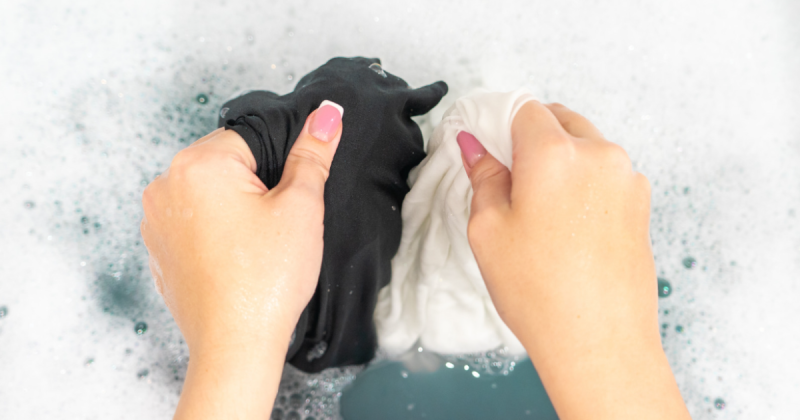We all want our favorite clothes to last as long as possible. Whether it’s a delicate blouse, a cozy sweater, or a well-loved pair of jeans, proper care can make a huge difference in preserving our garments’ quality, color, and fit. While modern washing machines are convenient, they aren’t always the best option for every fabric. Handwashing is a gentle, effective way to clean clothes and extend their lifespan. But let’s be honest—many of us avoid handwashing because it seems time-consuming or complicated. However, with the proper techniques, it’s pretty simple! Below, we’ll share essential handwashing tips, including when to wash your clothes and the best methods for different fabrics to keep them looking their best.
Why Handwashing Matters
Handwashing is not just about cleaning clothes; it’s about maintaining their integrity. Here’s why it’s worth the extra effort:
1. Preserves Fabric Quality
Washing machines can be harsh on delicate materials like silk, lace, and wool, causing fibers to weaken or fray over time. The agitation and spinning motions can lead to pilling, stretching, or even tearing in fragile fabrics. Handwashing allows you to control pressure and movement, ensuring a gentler cleaning process. By avoiding the rough treatment of a machine, your delicate garments maintain their original texture and structure for much longer.
2. Protects Embellishments
Items with sequins, embroidery, or lace are especially vulnerable to damage in a washing machine, as the tumbling motion can cause snagging or detachment. Even on a gentle cycle, intricate details may loosen, fray, or tangle with other clothing. Handwashing keeps embellishments intact by allowing you to clean around delicate decorations without unnecessary friction. This extra care ensures that your embellished pieces remain beautiful and well-preserved for years.
3. Extends the Life of Elastic
Bras, swimsuits, and leggings contain elastic fibers that can break down quickly when exposed to machine washing’s heat and agitation. Repeated stretching and twisting in a washer can weaken the elasticity, leading to sagging or loss of shape. Handwashing helps maintain the garment’s stretch and support by preventing unnecessary stress on the fibers. You can significantly extend their lifespan by gently cleansing these items and keeping them fitting comfortably.
4. Prevents Color Fading and Shrinking
Some fabrics, especially natural fibers like cotton, wool, and linen, lose their vibrancy or shrink when subjected to machine washing cycles. Hot water and aggressive spinning can cause dyes to bleed and fibers to contract, resulting in dull colors and a tighter fit. Handwashing with cold or lukewarm water helps preserve the fabric’s original hue and size. This careful approach ensures your clothes stay true to their intended look and feel, wash after wash.
When to Handwash Your Clothes
Not every piece of clothing needs to be hand-washed, but certain items benefit from the extra care. Consider handwashing if:
- The care label recommends it (look for the hand-in-water symbol).
- The fabric is delicate, like silk, lace, wool, or cashmere.
- The garment has elastic components that can degrade in high heat.
- It has stains that need targeted treatment.
- The item has embellishments like sequins, beads, or embroidery.
- You want to practice sustainability using less water and energy than a machine wash.
How to Handwash Clothes Properly
1. Read the Care Label
Before washing, always check the garment’s care instructions to ensure you’re using the correct cleaning method. Different fabrics require different care; some may be labeled as dry clean only, hand wash, or machine washable on delicate settings. Ignoring these guidelines can lead to shrinkage, fading, or damage that ruins the garment’s shape and texture. Test a small, inconspicuous area with water and detergent to ensure the fabric doesn’t react poorly. Taking a few seconds to read the label can prevent irreversible laundry disasters and help extend the life of your clothing.
2. Pre-Treat Stains
For stains, always pre-treat before washing to avoid setting them permanently into the fabric. Use a mild detergent or a stain remover that’s safe for delicate fabrics, applying it directly to the affected area. A solid laundry soap bar can be an excellent tool for tough stains like sweat, makeup, or food spills, as it allows for gentle yet effective cleaning. Gently rub the stained area and let the detergent soak for 10-15 minutes before rinsing or washing to help break down the stain particles. Pre-treating ensures that stains aren’t locked during washing, making maintaining your garment’s pristine look easier.
3. Fill a Sink or Basin with Water
The proper water temperature is essential to preserving your clothing’s color and shape. Use cold water for dark colors and delicate fabrics, as it helps prevent shrinking and fading while maintaining fabric integrity. Warm water works best for more durable fabrics like cotton or synthetic blends, helping to remove dirt and oils without excessive wear. Avoid hot water unless specifically recommended by the care label, as it can cause irreversible shrinkage or fabric weakening. Filling the sink or basin with the correct water temperature ensures that your garments stay clean without unnecessary damage.
4. Add a Gentle Detergent
Choose a mild detergent designed for delicate fabrics to prevent harsh chemical damage. Eco-friendly options like Dr. Bronner’s Pure Castile Liquid Soap work well because they are gentle yet effective at lifting dirt. Avoid using too much detergent—a small amount creates a light lather without leaving behind excess residue. Harsh detergents or excessive soap can strip the fabric of its natural softness, causing it to become stiff or irritated against the skin. Using the right detergent in moderation helps maintain the texture and longevity of your garments.
5. Submerge and Gently Wash
Once the detergent is added, submerge the garment thoroughly in the water and gently swirl it around to loosen dirt and oils. Lightly rubbing the fabric together in soiled areas can help lift grime, but avoid scrubbing aggressively, as this can cause wear and tear. Let the garment soak for 10-30 minutes, or longer for heavily soiled items, to allow the detergent to work effectively. Soaking helps break down dirt without harsh scrubbing, making it ideal for delicate fabrics. This step ensures a thorough but gentle cleaning process that keeps your clothing in excellent condition.
6. Rinse Thoroughly
After washing, drain the dirty water and refill the basin with clean, cold water to rinse out the detergent. Gently swish the garment around in the freshwater, removing all soap residue. Repeat this process as needed until the water runs clear and no visible suds are left on the fabric. Soap buildup can cause stiffness and irritation when worn, so thorough rinsing is key. Ensuring all detergent is removed keeps your clothing fresh, soft, and comfortable.
7. Avoid Wringing Out Water
Never twist or wring your clothes, as this can cause stretching, fabric damage, or loss of shape. Instead, press the garment against the side of the sink to squeeze out excess water without distorting the fibers. Lay the garment flat on a clean towel, roll it up, and gently press to absorb the remaining moisture. This method prevents stress on the fabric while still allowing efficient drying. Handling wet garments carefully ensures they retain their structure and remain in excellent condition after each wash.
Drying Clothes the Right Way
Handwashing is only half the battle—proper drying is just as important.
1. Lay Flat to Dry
For fabrics like wool, cashmere, and heavy knits, always lay the garment flat on a clean, dry towel to maintain its shape. Hanging these materials while wet can cause them to stretch under their weight, leading to misshapen sleeves and sagging hems. To help speed up drying, roll the towel with the garment inside and gently press to remove excess moisture before laying it flat. Keep the item in a well-ventilated area away from direct sunlight to prevent discoloration. This drying method ensures your knits and delicate fabrics retain their original fit and softness.
2. Hang Dry Lightweight Items
Using a hanger or drying rack is the best option for delicate fabrics like silk, lace, or synthetic blends. This allows proper airflow around the garment, reducing the chances of mildew and helping the fabric dry evenly. Choose padded or rounded hangers to prevent creases or distortion, especially for blouses and dresses. If drying indoors, place items near an open window or fan to encourage faster evaporation. Hang-drying preserves fabric integrity and helps keep clothes wrinkle-free, with minimal ironing needed.
3. Avoid the Dryer When Possible
High heat can weaken delicate fibers, shrink fabrics, and degrade elastic, leading to premature wear. Hang-drying is the safest option for most hand-washed garments, as it helps maintain their longevity and natural texture. If you must use a dryer, always select the lowest heat setting to reduce the risk of damage. Placing delicate items in a mesh laundry bag adds an extra layer of protection by preventing friction and stretching. Avoiding the dryer whenever possible helps extend the lifespan of your favorite clothing pieces.
4. Use the Sun’s Natural Bleaching Power
Exposing white fabrics to sunlight can act as a natural brightener, removing stains and giving them a fresh look. The sun’s UV rays help break down bacteria and odors, making it an eco-friendly alternative to harsh chemical bleaches. However, be cautious with dark or vibrant-colored garments, as prolonged exposure can cause fading and dullness. To protect colored fabrics, dry them in the shade or turn them inside out before placing them in indirect sunlight. Using the sun strategically can keep your whites bright while preserving the vibrancy of your darker clothing.
Sustainability Benefits of Handwashing
To make your laundry routine more eco-friendly, handwashing is a significant step. Here’s why:
- Uses less water compared to an entire washing machine cycle.
- Reduces electricity consumption, especially if you air-dry.
- It helps clothes last longer, reducing waste and fast fashion turnover.
Simple Handwashing Tips for Long-Lasting Clothes
Handwashing may seem like an extra chore, but it’s a simple way to keep your clothes looking new for longer. You can preserve fabric quality, prevent damage, and contribute to a more sustainable lifestyle with extra care. So next time you’re hesitant to toss your favorite piece into the machine, try handwashing—you might find it easier (and more effective) than you thought!






